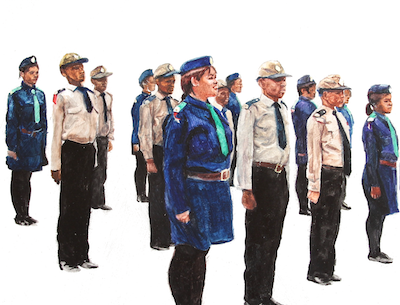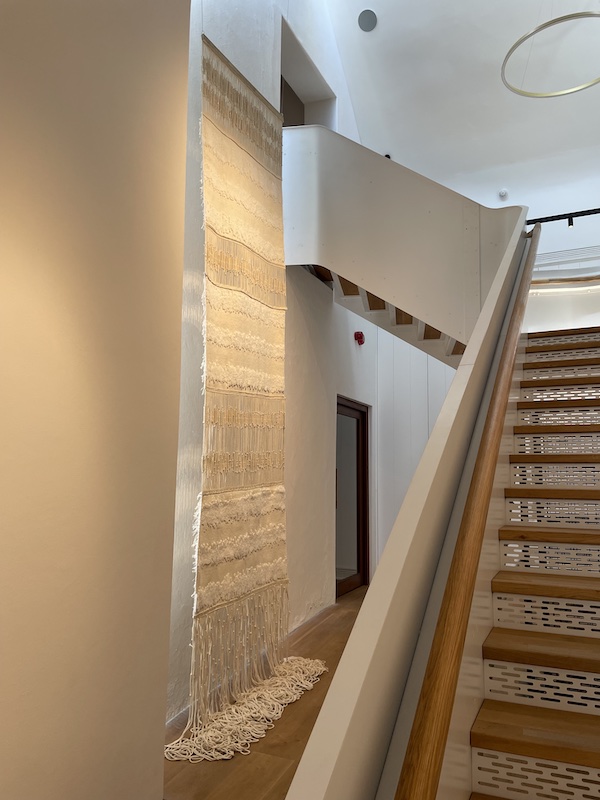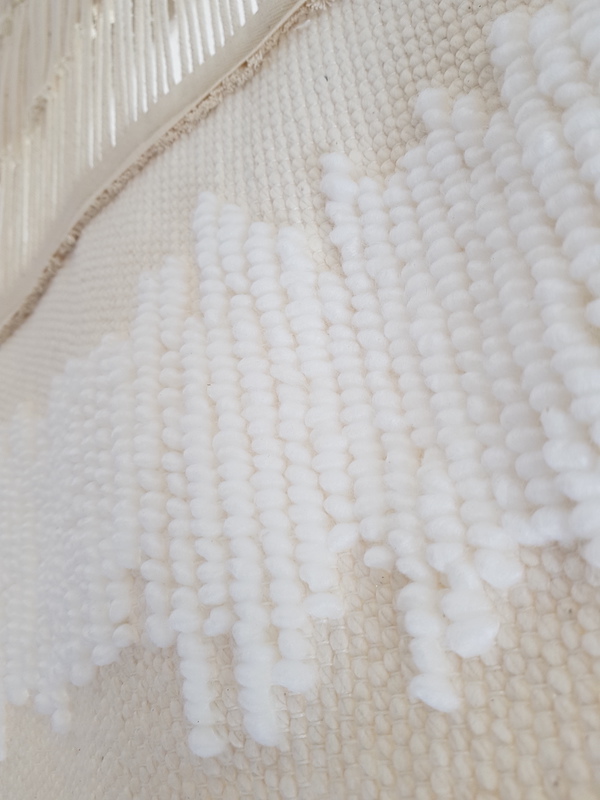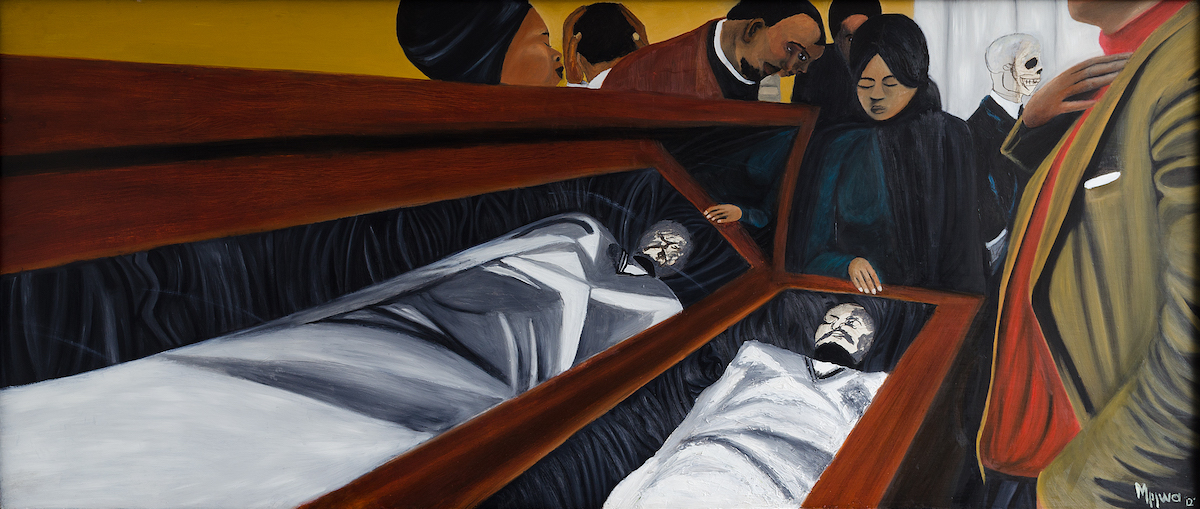Maryke van Velden writes on an exhibition she curated, which was hosted by the Oude Leeskamer Gallery in Stellenbosch, South Africa. Maryke van Velden is an artist and curator based in the Cape, South Africa. (See TBP 04.)

The image of a young Albie Sachs (1) pacing up and down a solitary cell, whistling to some stranger, has stuck with me for years since the first time I’d discovered his story in a BBC podcast. As a daily prison ritual (1963), Sachs and a (then) unknown detainee whistled to one another the main theme of the Largo movement from Dvořák’s “New World Symphony.” Their wordless communication was both creative protest and a means of solidarity.
Upon realizing that the following exhibition at Oude Leeskamer coincided with the season of Lent and Easter (2023), this story that emanates hope for reconciliation from a desolate place, once again haunted me. So there we were at the end of November 2022: three curators jamming to find harmonizing chords between the political and the religious. The prevalent, yet loaded, theme of “Reconciliation” surfaced as key. “Reconciliation? Isn’t that topic like ‘done’ in South Africa?” a friend remarks a couple of months later, after having visited the show. “Sure!” It’s fair to ask what more there is to say about this contested term. But this is also exactly the challenge: hasn’t “The Crucifixion” been “done” to the point of boredom? Easter together with Christmas are the two most difficult sermon topics. This is common knowledge for anyone who has grown up in a pastor’s home. As Christian and as curator my curiosity is as much in WHAT the gospel tells us, as in HOW it is told.

“To Whistle Back” brought together the work of thirteen South African artists, some contemporary and some who have passed on. Unique for a show in a contemporary art space and therefore rather special, is that each of these artists confesses to the Christian faith. A curatorial decision, of course. However, what I found most poignant throughout the planning process was an awareness of a representation of our broad socioeconomic spectrum among these artists, and the unique voice that each of them contributed from their experiences of faith. For one artist we bought and couriered art-making materials as he had lost all his existing artworks to arson and was left destitute. For another, an in-person meeting was set up to fill out agreement forms, due to linguistic and technological barriers. At the same time insurance was arranged for works worth six digits and masses of paperwork done to secure a loan from the incredible art collection of the Constitutional Court. If the body of the church, according to the book of Corinthians, is made of many parts, then this group of artists is analogous to just that.
Lent is a time of barrenness. A desert stint. A time during which Christians retract and acknowledge the brokenness of this world we live in. Since the start of this exhibition, 2023 has, for many in my inner circle, brought about drastic and traumatic changes: cancer diagnoses, failed relationships, unemployment, a limb amputation, retirement, loss of funding, sudden premature death … the type of existential crossroads that leaves one at a loss for words. And searching for hope.
What strikes me about the hopeful whistling between the inmates of two bleak prison cells sixty years ago is the components of ritual and a call for communion, decades before restoration revealed itself. These senses of ritual and of communion emerge in several of the artworks that were featured in “To Whistle Back.” As a response to his empathetic concern of shanty town inhabitants during the Covid-19 lockdown, Walter Hayn starts a meditative drawing that leads to the representation of an impenetrable church structure in his Church of the Dispossessed. An image which encourages a questioning of the ideological barriers we might be erecting and who it is we exclude from our communities.


As a means of processing the insurmountable inequality and impact of corruption in our country, Franli Meintjes employs a repetitive piercing technique of needle through wool. Her tactile work, Our Prayer, represents the digital sound waves produced when singing the Xhosa hymn, “Nkosi Sikelel’ iAfrika,” (“God bless Africa”): a repetition that stretches over six metres.
Bonnie Ntshalintshali renders the Old Testament characters of Joseph and Elijah in her distinctively spirited style and paradoxically bright colours. What did Ntshalintshali, an artist who had lived with HIV at a time when stigma about the disease was rife, grasp about God’s care and provision under trying circumstances, and in unexpected ways? Included were Paul Greenway’s wrenching stop-frame animation documenting his three-day-long digging of a grave for a pauper (EA 61: Mayfield Cemetery, 2012), Ydi Coetsee’s painting that acknowledges the unsung heroes from the Uniting Reformed Church’s brigade (VGK Brigade, Maitland, 2023), and Sophie Peters’ simple early etching of a crucifixion scene featuring the disciple Peter (Crucifixion, 1987).


It is not that I imagine any of these artworks to possess some transcendental quality that would wipe out the pain or confusion or solitude that the tides of (this) life are guaranteed to throw upon us. But, in a liturgical manner, I am convinced that art breathes into our imagination (and dogma!) to reawaken truth and to restore. Art tells the gospel in a new tongue.
As aptly stated in his essay “Holy Beauty,” John W. De Gruchy writes: “[A]rt has the potential to change both our personal and corporate consciousness and perception, challenging perceived reality and enabling us to remember what was best in the past even as it evokes fresh images that serve transformation in the present. This it does through its ability to evoke imagination and wonder, causing us to pause and reflect and thereby opening up the possibility of changing our perception and ultimately our lives.”
May the tune we whistle be a confident echo of what we hope for but cannot see.
“To Whistle Back” was shown at the Oude Leeskamer Gallery, Stellenbosch, from 2 February to 22 March 2023, in collaboration with 40 Stones. Joseph Buys, Ydi Coetsee Carstens, Paul Greenway, Jonathan Griffiths, Walter Hayn, Leonard Matsoso, Franli Meintjes, Ntobeko Mjijwa, Bonnie Ntshalintshali, Odous, Sophie Peters, Chris Soal and Maryke van Velden participated. Professor John De Gruchy’s opening address, “Fynart as a Means of Grace,” can be read in the Kerkbode column about the exhibition (09/02/2023).

The Kirby Laing Centre for Public Theology in Cambridge. Charity registered in England and Wales. Charity Number: 1191741
Kirby Laing Centre, The New Mill House, Unit 1, Chesterton Mill, French’s Road, Cambridge, CB4 3NP
© 2022 The Kirby Laing Centre for Public Theology in Cambridge